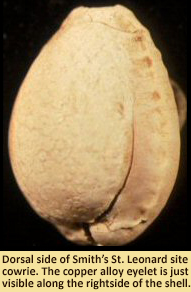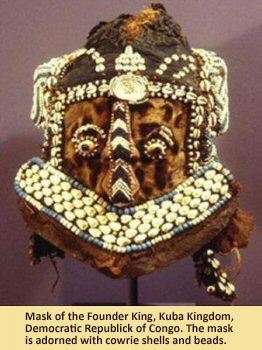Modified Cowrie Shell
January 2008
By Patricia Samford, MAC Lab Director
 This unusual cowrie shell was recovered in June 2005 from the Smith's St. Leonard site, in Calvert County, Maryland. Two cowrie shells were found about 15 feet apart in the plowzone adjacent to the main house of this large plantation, which was occupied during the first half of the 18th century. One of the shells is a typical find, with the top or dorsal surface removed. The shell pictured here, however, is different. The shell is intact, and molten lead had been poured into the back aperture. A copper alloy eyelet was then inserted into the lead. It is not clear if this cowrie was used as a button or pendant, or had some other special function. However, the metal was added to the shell in a crude fashion, so it does not appear to be the work of a jeweler or master craftsman.
This unusual cowrie shell was recovered in June 2005 from the Smith's St. Leonard site, in Calvert County, Maryland. Two cowrie shells were found about 15 feet apart in the plowzone adjacent to the main house of this large plantation, which was occupied during the first half of the 18th century. One of the shells is a typical find, with the top or dorsal surface removed. The shell pictured here, however, is different. The shell is intact, and molten lead had been poured into the back aperture. A copper alloy eyelet was then inserted into the lead. It is not clear if this cowrie was used as a button or pendant, or had some other special function. However, the metal was added to the shell in a crude fashion, so it does not appear to be the work of a jeweler or master craftsman.
This shell has been identified as a money cowrie (Cyprea moneta), one of approximately two hundred recognized species of cowrie. Cowries occur in warm and shallow lagoons and basins of the Indian and Pacific Oceans, although the Maldive Islands were the source of most
Cyprea moneta entering the world trade (Hogendorn and Johnson 1986:7).
 For centuries, cowrie shells have served many functions throughout the world. Cowries have played decorative and religious roles in a number of cultures. They have been recovered from Early Iron Age burials in Italy and England, were worn as amulets by women to promote fertility, and carried in various European cultures as good luck amulets (Hildburg 1942). The use of cowries for ornamentation and decoration in parts of West Africa can be traced back as far as the 11th century (Ogundiran 2002:438). Sewn onto clothing, made into jewelry, and woven into the hair, cowries not only served as adornment, but as symbols of status and wealth (Pearce 1992). A small hole pierced in the anterior or posterior end of the shell would allow it to be suspended from a cord and worn as a pendant.
For centuries, cowrie shells have served many functions throughout the world. Cowries have played decorative and religious roles in a number of cultures. They have been recovered from Early Iron Age burials in Italy and England, were worn as amulets by women to promote fertility, and carried in various European cultures as good luck amulets (Hildburg 1942). The use of cowries for ornamentation and decoration in parts of West Africa can be traced back as far as the 11th century (Ogundiran 2002:438). Sewn onto clothing, made into jewelry, and woven into the hair, cowries not only served as adornment, but as symbols of status and wealth (Pearce 1992). A small hole pierced in the anterior or posterior end of the shell would allow it to be suspended from a cord and worn as a pendant.
Cowries are perhaps most widely known for their use as currency in Africa, where they figured prominently in the economy of the slave trade. The use of cowries as currency in West Africa was firmly in place by the initial period of European contact (Hogendorn and Johnson 1986:18). Because it was impossible to mint coins with as
 low a value as a single cowrie, they were particularly well-suited for small transactions like local market purchases (Hogendorn and Johnson 1986:2). Cowries also served ritual and religious functions in West Africa, serving as divination tools and incorporated as components of sacred objects and shrines (Ogundiran 2002).
low a value as a single cowrie, they were particularly well-suited for small transactions like local market purchases (Hogendorn and Johnson 1986:2). Cowries also served ritual and religious functions in West Africa, serving as divination tools and incorporated as components of sacred objects and shrines (Ogundiran 2002).
Cowries have been found in small quantities on archaeological sites occupied by European Americans, African Americans and Native Americans in the eastern U. S. (Pearce 1992). It is not clear who owned or used the cowries from the Smith's St. Leonard site. Their rough appearance might suggest that they were not used as jewelry by the wealthy white landowners, and a quarter for enslaved Africans was located just a couple of hundred feet from the find site. However, there is good evidence that someone living on the plantation in the 18th century was collecting prehistoric Indian artifacts, so it is possible that the cowries were curios. Future excavations at the site will perhaps clarify this.
While it is typical to find complete cowrie shells, or shells that have been pierced with small holes or missing part of the dorsal surface, the lead-filled Smith' St. Leonard shell is very unusual. If anyone has seen a similar shell, or might have ideas or suggestions about this object, please contact Edward Chaney of the Maryland Archaeological Conservation Laboratory at 410-586-8554 or [email protected].
|
References |
|
| Hildburgh, W. L. |
| 1942 | Cowrie Shells as Amulets in Europe.
Folklore. Volume 53, No. 4:178-195. |
|
| Hogendorn, Jan and Marion Johnson |
| 1986 |
The Shell Money of the Slave Trade. Cambridge University Press, New York. |
|
| Ogundiran, Akinwumi |
| 2002 | Of Small Things Remembered: Beads, Cowries, and Cultural Translations of the Atlantic Experience in Yorubaland.
International Journal of African Historical Studies. Volume 35, Nos. 2-3:427-457. |
|
| Pearce, Laurie E. |
| 1992 |
The Cowrie Shell in Virginia; a Critical Evaluation of Potential Archaeological Significance. Master’s thesis, Anthropology Department, College of William and Mary, Williamsburg, Virginia. |
|